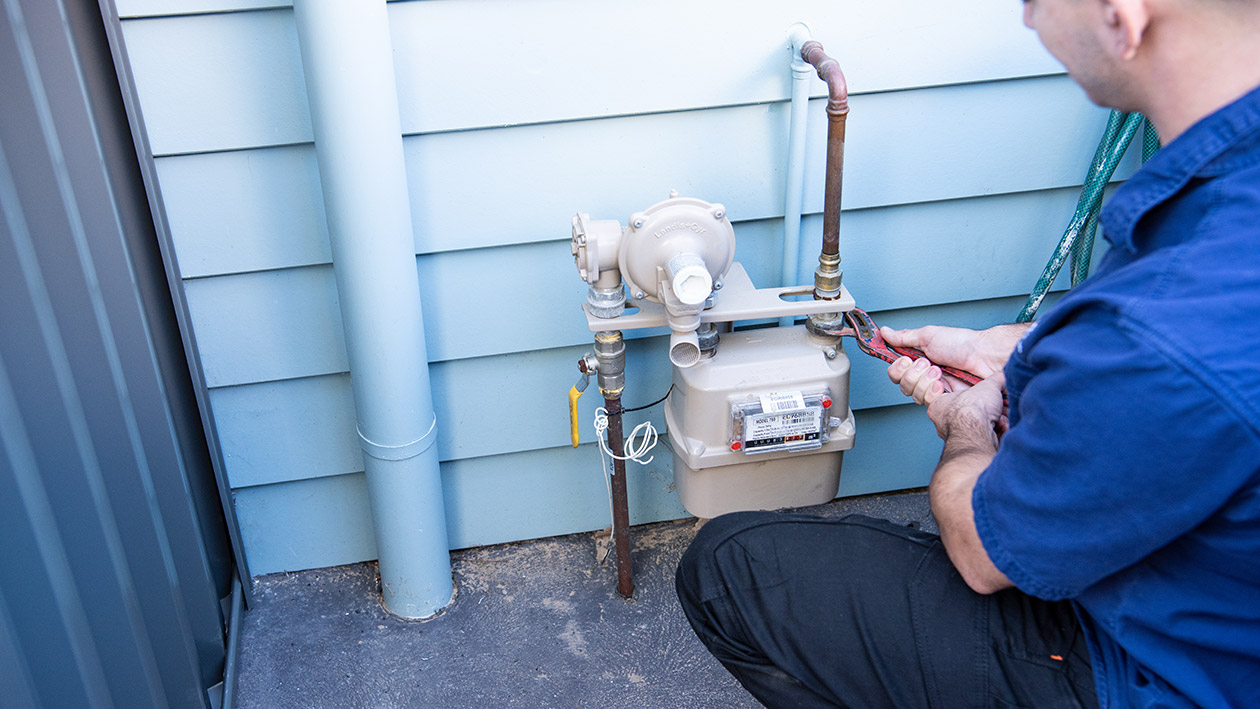Thinking of adding a gas stove, fireplace, or heating system to your home? Or maybe you’re looking to relocate an existing gas appliance? Whatever your reason, understanding gas line installation is essential.
While the convenience and efficiency of natural gas are undeniable, dealing with gas lines is not a DIY project. It requires strict adherence to safety regulations, specialised knowledge, and a healthy dose of caution.
This guide will walk you through the ins and outs of gas line installation, answering common questions and highlighting the critical role of licensed gas fitters in ensuring a safe and compliant setup.
In this guide:
- Is Installing a Gas Line Safe to DIY or Do I Need a Pro?
- What Type of Gas Line Pipe and Fittings Do I Need?
- How Deep Should I Bury My Gas Line? And What About Other Utilities?
- How Do I Install a Gas Line Step-by-Step?
- Can I Run a Gas Line Through a Wall or Outside My House?
- What Australian Standards must you look at when installing a gas pipe system?
Is Installing a Gas Line Safe to DIY or Do I Need a Pro?
Installing a gas line in Australia is unsafe as a DIY project and requires a licensed gas fitter. This is mandated by law for safety reasons. Only qualified professionals have the proper training and certification to install gas lines legally.
Gas line installation involves significant safety risks if not done properly:
- Gas leaks can lead to explosions or fires
- Improper installation can result in carbon monoxide poisoning
- Incorrect sizing or materials can cause dangerous pressure issues
Professional gas fitters understand how to mitigate these risks through proper techniques, testing, and adherence to safety codes.
Warning: Installing a gas line is not a DIY project and legally requires a certified professional. Find out exactly what a gas fitter does and why you must hire one for this type of work.
What Type of Gas Line Pipe and Fittings Do I Need?
Choosing the right materials for your gas line is crucial for safety and durability. Here’s a guide to help you understand the options:
Gas Line Materials
- Black Iron Pipe (BI):
- Pros: Strong, durable, resistant to heat and physical damage, traditional choice for gas lines.
- Cons: Prone to rust and corrosion over time, requires threading for connections (labour-intensive), can be more expensive than other options.
- Corrugated Stainless Steel Tubing (CSST):
- Pros: Flexible, easier to install than black iron, resistant to corrosion, good for earthquake-prone areas.
- Cons: Can be punctured by sharp objects, requires specific grounding procedures to mitigate lightning risks.
- Copper Tubing:
- Pros: Corrosion resistant, aesthetically pleasing, suitable for indoor use.
- Cons: Not as strong as black iron or CSST, can be damaged by freezing temperatures, typically used for short runs.
- Polyethylene (PE) Pipe:
- Pros: Flexible, lightweight, corrosion resistant, often used for underground gas lines.
- Cons: Not suitable for above-ground applications, can be susceptible to rodent damage.
Essential Gas Line Fittings
- Couplings: Used to join two pieces of pipe of the same diameter.
- Elbows: Used to create bends or changes in direction.
- Tees: Used to create branch lines off the main gas line.
- Valves: Essential for shutting off gas flow for maintenance or emergencies.
- Regulators: Used to control gas pressure to the appropriate level for appliances.
Factors to Consider When Choosing Materials
- Gas Type: Natural gas and propane have different pressure requirements and may require specific pipe materials.
- Location (Indoor/Outdoor): Some materials (like black iron) are more suitable for outdoor applications, while others (like copper) are better suited for indoor use.
- Appliance Requirements: Check the manufacturer’s specifications for your gas appliances, as they may specify certain pipe sizes or materials.
- Local Building Codes: Always consult your local building codes, as they may dictate specific requirements for gas line materials and installation practices.
How Deep Should I Bury My Gas Line? And What About Other Utilities?
In Australia, the minimum depth for burying gas lines varies depending on location and local regulations. Generally, aim for a depth of at least 300mm (12 inches) below ground level. However, it’s crucial to:
- Consult Local Codes: Contact your local council or state authority for specific depth requirements in your area. These may differ based on soil type, traffic conditions, and frost lines.
- Deeper for Driveways and Roads: If the gas line runs under a driveway or road, a greater depth (up to 600mm or 24 inches) might be necessary to prevent damage from vehicles.
Safe Digging Practices: Avoiding Underground Hazards
Before you start digging, it’s crucial to locate and mark the position of any existing underground utilities, such as:
- Electricity: Contact your electricity provider to have them mark power lines.
- Water and Sewer: Contact your water authority for the location of water mains and sewer lines.
- Telecommunications: Contact your phone and internet providers to locate any underground cables.
Dial Before You Dig: In Australia, you can call or go online to “Dial Before You Dig” to request a free utility location service.
Techniques for Running Gas Lines Near Other Utilities
- Maintain Safe Distances: When running a gas line near other utilities, maintain a minimum horizontal separation distance of 300mm (12 inches).
- Use Protective Sleeving: If closer proximity is unavoidable, encase the gas line in a protective polyethylene or steel sleeve to prevent damage.
- Consult Professionals: Always consult a licensed plumber or gas fitter for complex installations or when working near existing utilities to ensure safe and compliant work.
How Do I Install a Gas Line Step-by-Step?
Disclaimer: This guide provides general information only. Installing gas lines is dangerous and should always be performed by a licensed gas fitter. This information is illustrative to help you understand the process and is not a substitute for professional expertise.
1. Planning and Preparation
- Determine Requirements: Identify the gas appliance(s) to be connected, their required gas pressure and flow rate, and the total length of the gas line.
- Plan the Route: Choose the most direct and accessible route, minimising bends and elevation changes. Consider future landscaping and avoid areas prone to disturbance.
- Obtain Permits: Contact your local council for necessary permits and inspections.
- Gather Materials and Tools: This includes the chosen gas line pipe, fittings, gas shut-off valve, pipe thread sealant, pipe wrenches, a tubing cutter (if using copper), and safety equipment
2. Digging the Trench
- Mark the Path: Use string and stakes to clearly mark the gas line’s route.
- Excavate the Trench: Dig a trench at least 300mm (12 inches) deep, or deeper as required by local codes. Ensure the trench is wide enough for easy access and backfilling.
- Create a Level Base: Compact the bottom of the trench to create a stable base for the gas line.
3. Assembling and Installing the Gas Line
- Measure and Cut Pipe: Carefully measure and cut the pipe to the required lengths, ensuring square cuts for proper fitting connections.
- Thread or Join Pipe: Use threading (for black iron pipe) or appropriate joining methods (for CSST or copper), depending on the pipe material.
- Apply Pipe Thread Sealant: To prevent leaks, apply a thin layer of approved gas-rated pipe thread sealant to male pipe threads before connecting fittings.
- Assemble Sections: Connect pipe sections with fittings, using two pipe wrenches to tighten them securely. Avoid overtightening, which can damage fittings or the pipe.
- Install the Shutoff Valve: Place the main gas shut-off valve where the gas line enters your home or building. This allows you to shut off gas flow easily during emergencies or maintenance.
4. Connecting to the Gas Source and Appliance
- Connect to Gas Meter: This connection is typically made by the gas utility company.
- Connect to Appliance: Follow manufacturer instructions to connect the gas line to your appliances using appropriate flexible gas connectors.
5. Leak Testing and Backfilling
- Pressure Test the Line: A licensed gas fitter will perform a pressure test using a specialised gauge to check for leaks. Never attempt this yourself.
- Inspect for Leaks: If any leaks are detected, tighten connections or replace faulty components.
- Backfill the Trench: Once the gas line passes the pressure test, carefully backfill the trench, compacting the soil in layers.
Can I Run a Gas Line Through a Wall or Outside My House?
Running a gas line through a wall, ceiling, or outside your house involves additional safety considerations and regulations. Remember, these are complex procedures best left to licensed gas fitters.
Regulations and Considerations
- Always Consult Local Codes: Regulations for interior and exterior gas lines vary significantly. Contact your local council or building authority for specific requirements in your area.
- Interior Gas Lines: May require fire-resistant coverings, specific pipe materials, and ventilation measures to prevent gas buildup in enclosed spaces.
- Exterior Gas Lines: Need protection from physical damage, weather exposure, and corrosion. They may require specific depths for burying, as well as protection from lawnmowers and other potential hazards.
Installation Techniques
- Through Walls and Ceilings:
- Protective Sleeves: Encase the gas line where it passes through combustible materials like wood framing with metal or fire-resistant sleeves. Seal any gaps around the sleeve with fire-resistant sealant.
- No Concealed Joints: Ensure no pipe joints are concealed within walls or ceilings. All connections should be accessible for inspection and maintenance.
- Through Crawl Spaces:
- Proper Support: Adequately support the gas line within the crawl space to prevent sagging or damage.
- Protection from Moisture: Use corrosion-resistant materials or apply protective coatings to shield the gas line from moisture.
- Ventilation: Ensure adequate ventilation in the crawl space to prevent gas buildup.
Weatherproofing and Protection for Exposed Gas Lines
- Underground Lines:
- Depth: Bury lines at the required depth to prevent freezing and damage from gardening tools.
- Warning Tape: Lay warning tape above underground gas lines to alert others during digging.
- Above-Ground Lines:
- Protective Covers: Use weather-resistant coverings, like PVC or metal conduit, to protect exposed lines from UV rays, rain, and physical damage.
- Secure Mounting: Use appropriate brackets or clamps to mount above-ground lines to the building structure.
- Corrosion Protection: Apply protective coatings, like paint or sealant, to exposed metal pipes to prevent rust and corrosion.
What Australian Standards must you look at when installing a gas pipe system?
The key Australian Standards and regulations related to gas fitting include:
AS/NZS 5601.1:2022 Gas Installations
This is the primary standard for gas installations in Australia and New Zealand. It sets out requirements for designing, installing and commissioning gas installations used with natural gas, LP Gas, or biogas [1]. Key aspects include:
- Safety requirements and compliance measures
- Materials, fittings, and components specifications
- Consumer piping design and installation
- Flue design and installation
- Appliance installation guidelines
The standard was recently revised with significant changes to improve safety, including:
- New requirements for multilayer gas pipes to mitigate fire risks
- Prohibition on installing multilayer pipes above ground externally
- Mandating shutoff valves near gas supply points in new buildings
Other Relevant Standards
- AS/NZS 1596:2014 – Covers storage and handling of LP Gas
- AS 2885 – Relates to gas and liquid petroleum pipelines
- AS 3723 – Covers installation and maintenance of plastic pipe systems for gas
Regulatory Framework
Gas fitting work in Australia is strictly regulated:
- Only licensed gas fitters can legally perform gas installation work
- Work must comply with relevant Australian Standards
- Permits and inspections are typically required for gas installations
Each state/territory has its own specific regulations, but they generally reference the national standards
For example, in New South Wales:
- The Gas and Electricity (Consumer Safety) Regulation 2018 enforces AS/NZS 5601:2022 and AS/NZS 1596:2014
- NSW Fair Trading provides advisory notes for the gas fitting industry on technical solutions, compliance, and installation requirements
It’s crucial for gas fitters to stay updated on the latest standards and regulations, as they are periodically revised to enhance safety and incorporate new technologies in the gas industry.



